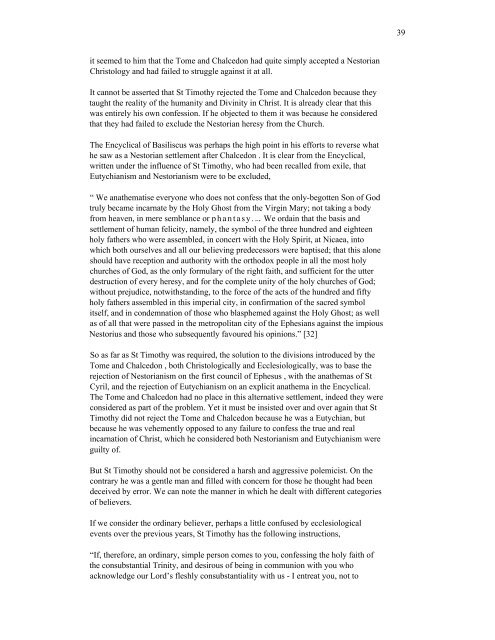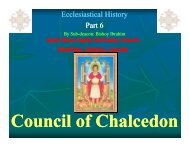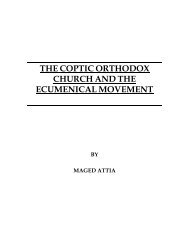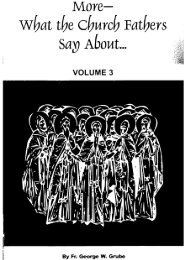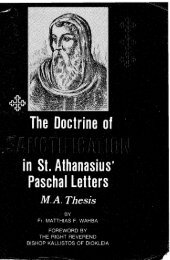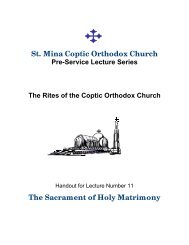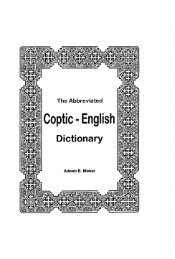Coptic interpretations of the Fourth Ecumenical Council - Saint Mina ...
Coptic interpretations of the Fourth Ecumenical Council - Saint Mina ...
Coptic interpretations of the Fourth Ecumenical Council - Saint Mina ...
Create successful ePaper yourself
Turn your PDF publications into a flip-book with our unique Google optimized e-Paper software.
it seemed to him that <strong>the</strong> Tome and Chalcedon had quite simply accepted a Nestorian<br />
Christology and had failed to struggle against it at all.<br />
It cannot be asserted that St Timothy rejected <strong>the</strong> Tome and Chalcedon because <strong>the</strong>y<br />
taught <strong>the</strong> reality <strong>of</strong> <strong>the</strong> humanity and Divinity in Christ. It is already clear that this<br />
was entirely his own confession. If he objected to <strong>the</strong>m it was because he considered<br />
that <strong>the</strong>y had failed to exclude <strong>the</strong> Nestorian heresy from <strong>the</strong> Church.<br />
The Encyclical <strong>of</strong> Basiliscus was perhaps <strong>the</strong> high point in his efforts to reverse what<br />
he saw as a Nestorian settlement after Chalcedon . It is clear from <strong>the</strong> Encyclical,<br />
written under <strong>the</strong> influence <strong>of</strong> St Timothy, who had been recalled from exile, that<br />
Eutychianism and Nestorianism were to be excluded,<br />
“ We ana<strong>the</strong>matise everyone who does not confess that <strong>the</strong> only-begotten Son <strong>of</strong> God<br />
truly became incarnate by <strong>the</strong> Holy Ghost from <strong>the</strong> Virgin Mary; not taking a body<br />
from heaven, in mere semblance or phantasy... We ordain that <strong>the</strong> basis and<br />
settlement <strong>of</strong> human felicity, namely, <strong>the</strong> symbol <strong>of</strong> <strong>the</strong> three hundred and eighteen<br />
holy fa<strong>the</strong>rs who were assembled, in concert with <strong>the</strong> Holy Spirit, at Nicaea, into<br />
which both ourselves and all our believing predecessors were baptised; that this alone<br />
should have reception and authority with <strong>the</strong> orthodox people in all <strong>the</strong> most holy<br />
churches <strong>of</strong> God, as <strong>the</strong> only formulary <strong>of</strong> <strong>the</strong> right faith, and sufficient for <strong>the</strong> utter<br />
destruction <strong>of</strong> every heresy, and for <strong>the</strong> complete unity <strong>of</strong> <strong>the</strong> holy churches <strong>of</strong> God;<br />
without prejudice, notwithstanding, to <strong>the</strong> force <strong>of</strong> <strong>the</strong> acts <strong>of</strong> <strong>the</strong> hundred and fifty<br />
holy fa<strong>the</strong>rs assembled in this imperial city, in confirmation <strong>of</strong> <strong>the</strong> sacred symbol<br />
itself, and in condemnation <strong>of</strong> those who blasphemed against <strong>the</strong> Holy Ghost; as well<br />
as <strong>of</strong> all that were passed in <strong>the</strong> metropolitan city <strong>of</strong> <strong>the</strong> Ephesians against <strong>the</strong> impious<br />
Nestorius and those who subsequently favoured his opinions.” [32]<br />
So as far as St Timothy was required, <strong>the</strong> solution to <strong>the</strong> divisions introduced by <strong>the</strong><br />
Tome and Chalcedon , both Christologically and Ecclesiologically, was to base <strong>the</strong><br />
rejection <strong>of</strong> Nestorianism on <strong>the</strong> first council <strong>of</strong> Ephesus , with <strong>the</strong> ana<strong>the</strong>mas <strong>of</strong> St<br />
Cyril, and <strong>the</strong> rejection <strong>of</strong> Eutychianism on an explicit ana<strong>the</strong>ma in <strong>the</strong> Encyclical.<br />
The Tome and Chalcedon had no place in this alternative settlement, indeed <strong>the</strong>y were<br />
considered as part <strong>of</strong> <strong>the</strong> problem. Yet it must be insisted over and over again that St<br />
Timothy did not reject <strong>the</strong> Tome and Chalcedon because he was a Eutychian, but<br />
because he was vehemently opposed to any failure to confess <strong>the</strong> true and real<br />
incarnation <strong>of</strong> Christ, which he considered both Nestorianism and Eutychianism were<br />
guilty <strong>of</strong>.<br />
But St Timothy should not be considered a harsh and aggressive polemicist. On <strong>the</strong><br />
contrary he was a gentle man and filled with concern for those he thought had been<br />
deceived by error. We can note <strong>the</strong> manner in which he dealt with different categories<br />
<strong>of</strong> believers.<br />
If we consider <strong>the</strong> ordinary believer, perhaps a little confused by ecclesiological<br />
events over <strong>the</strong> previous years, St Timothy has <strong>the</strong> following instructions,<br />
“If, <strong>the</strong>refore, an ordinary, simple person comes to you, confessing <strong>the</strong> holy faith <strong>of</strong><br />
<strong>the</strong> consubstantial Trinity, and desirous <strong>of</strong> being in communion with you who<br />
acknowledge our Lord’s fleshly consubstantiality with us - I entreat you, not to<br />
39


